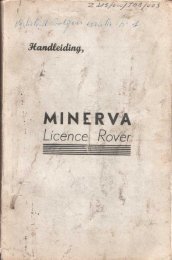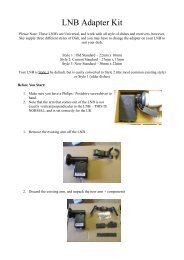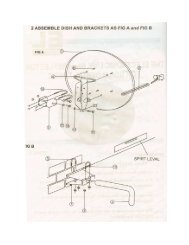Labor Operation Times - Internet-Tools.co.uk
Labor Operation Times - Internet-Tools.co.uk
Labor Operation Times - Internet-Tools.co.uk
You also want an ePaper? Increase the reach of your titles
YUMPU automatically turns print PDFs into web optimized ePapers that Google loves.
LABOR OPERATION USE<br />
Engineers, Product Reliability and Warranty Administration Groups utilize repair or fault <strong>co</strong>des for<br />
various reasons. For this reason, it is extremely important that <strong>co</strong>rrect and appropriate labor<br />
operation numbers are selected and entered on the warranty claim.<br />
Each claim must begin with the labor operation that caused the <strong>co</strong>mplaint. In the case where a<br />
failure causes other faults, i.e. axle seal <strong>co</strong>ntaminates brake pad linings, the first operation number<br />
to be entered into the warranty claim system is the labor operation number to replace the axle<br />
seal.<br />
The labor operation to replace the brake pads is se<strong>co</strong>nd within the same claim number. This format<br />
allows the LRNA Warranty System to assign the appropriate failure <strong>co</strong>de for Land Rover statistical<br />
and analysis uses. This also puts the repair into perspective.<br />
NON - SCHEDULED TIME<br />
If an operation does not exist for a repair, use a "00" operation. To do this, substitute the 5thand<br />
6thcharacters with "00"e.g. 12.60.32be<strong>co</strong>mes 12.60.00. Only the actual time taken to perform the<br />
repair should be claimed. All unscheduled labor must be documented by clock times.<br />
In the event that both scheduled and unscheduled operations are claimed for a single repair and<br />
only one clock time is used, (no separate time punch used for unscheduled) LRNA will allow a<br />
maximum of 100% efficiency for the entire job. The portion being claimed as unscheduled time<br />
shall be equal to the clock time less the allowance for the scheduled labor operation.<br />
OVERLAP<br />
<strong>Labor</strong> operations that clearly include removal and replacement of one <strong>co</strong>mponent to replace a<br />
different <strong>co</strong>mponent, as outlined in the Workshop Manual, cannot be submitted as two separate<br />
labor operations. For example, no additional time is allowed to replace the water pump (26.50.01) if<br />
at the same time the front timing gasket (12.65.04) is being replaced.<br />
CUSTOMER PROBLEM ANALYSIS, SYSTEM DIAGNOSIS & REPAIR TESTING<br />
The following are definitions of the terms used in the preceding statement:<br />
Customer problem analysis - The process of transacting the customer’s <strong>co</strong>ncern, <strong>co</strong>mplaint, or<br />
question to a symptom that can effectively be addressed by a technician if needed, i.e. A/C<br />
insufficient <strong>co</strong>oling, brakes pull, engine hesitates, etc. "Customer Problem Analysis" includes<br />
those <strong>co</strong>nditions which are readily apparent to the normal senses of sight, touch, sound and smell.<br />
"Customer Problem Analysis"is the duty of service management and/or the service advisor.<br />
Symptom Diagnosis - The process of finding the source of a problem based on a detailed,<br />
systematic and logical approach, i.e. finding the source of an electrical problem by following the<br />
trouble trees and/or diagnostic charts. "Symptom Diagnosis"is the responsibility of the technician<br />
and is included in the published labor time guide allowances.<br />
Repair Testing - The checks, tests and measurements needed in the repair to find the cause of<br />
failure or identify faulty parts. Examples are:<br />
* Cleaning and inspection of all parts such as gears, clutch plates.<br />
* Use of test equipment classified as LRNA essential tools.<br />
* Use of <strong>co</strong>mmon testers such as volt-ohmmeter, ammeter or timing light that are included in<br />
service manuals and technical service publications.<br />
4













